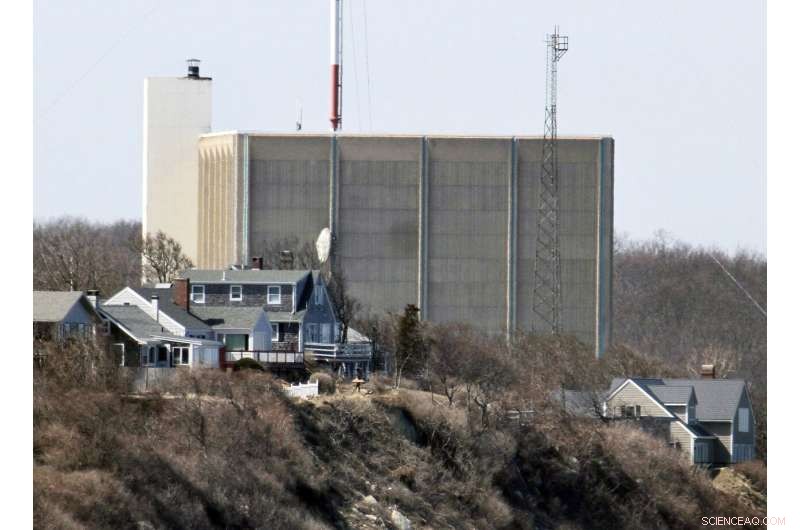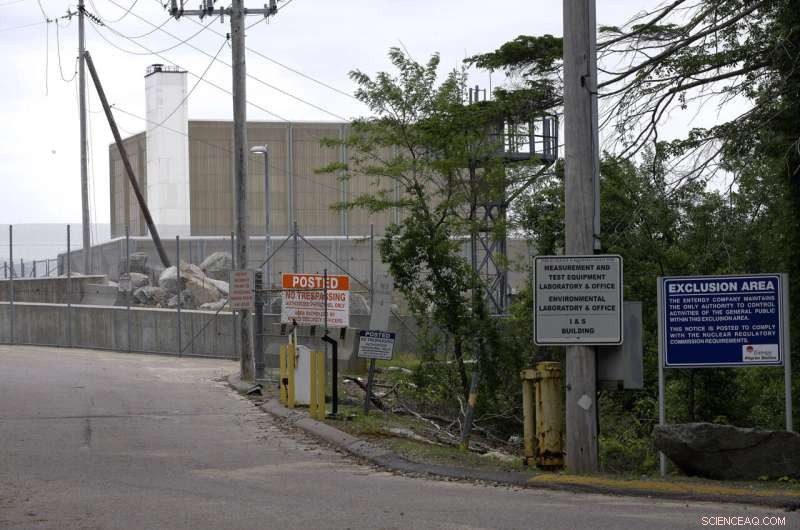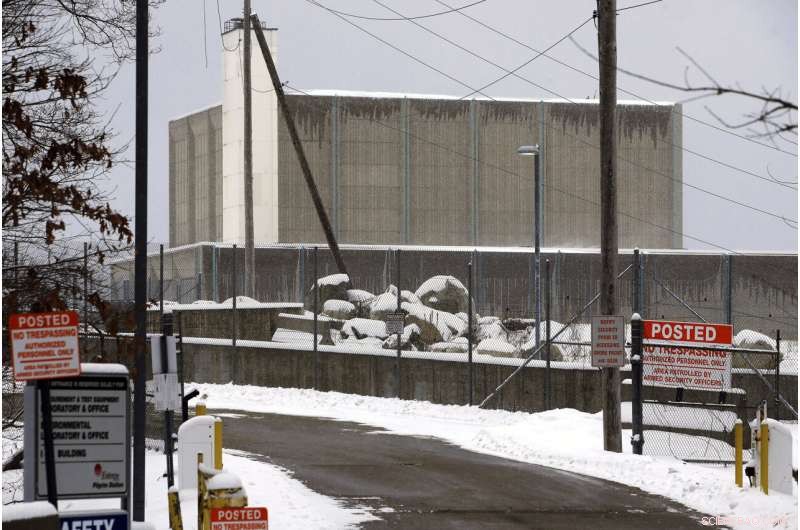
Uma parte da Usina Nuclear Pilgrim é visível além das casas ao longo da costa de Cape Cod Bay, em Plymouth, Massachusetts, 30 de março de 2011. Pilgrim, que fechou em 2019, era um reator de água fervente. A água circulava constantemente através do vaso do reator e do combustível nuclear, convertendo-o em vapor para girar a turbina. A água foi resfriada e recirculada, captando contaminação radioativa. Crédito:AP Photo/Steven Senne, Arquivo
Um milhão de galões de água radioativa está dentro de uma antiga usina nuclear ao longo de Cape Cod Bay e tem que ir.
Mas onde está a questão vexatória e o Estado intervirá quando a empresa desmantelar a usina decidir?
A Holtec International está considerando tratar a água e descarregá-la na baía, atraindo forte resistência de moradores locais, pescadores de conchas e políticos. A Holtec também está considerando evaporar a água contaminada ou transportá-la para uma instalação em outro estado.
A luta em Massachusetts reflete um debate atual e acalorado no Japão sobre um plano para liberar mais de 1 milhão de toneladas de águas residuais radioativas tratadas no oceano da usina nuclear destruída de Fukushima na primavera de 2023. Um enorme tsunami em 2011 atingiu a usina. Três reatores derreteram.
A Usina Nuclear Pilgrim em Plymouth, Massachusetts, fechou em 2019 depois de quase meio século fornecendo eletricidade para a região. O deputado americano William Keating, um democrata cujo distrito inclui o Cabo, escreveu para Holtec com outros legisladores importantes de Massachusetts em janeiro para se opor à liberação de água na Baía de Cape Cod. Ele pediu à Comissão Reguladora Nuclear dos EUA para examinar seus regulamentos.
Keating disse no final de março que o manuseio da água radioativa pela Holtec poderia abrir um precedente porque a indústria de desativação dos EUA está em sua infância. A maioria das usinas nucleares dos EUA foi construída entre 1970 e 1990.
"Se eles estão ouvindo, sensíveis e trabalham com essas comunidades, é importante", disse ele. "Essa é a mensagem para futuros locais de descomissionamento."
A Holtec adquiriu usinas nucleares fechadas em todo o país como parte de seus negócios de desmantelamento, incluindo a antiga Oyster Creek Generating Station em Nova Jersey e o Indian Point Energy Center em Nova York. Está tomando posse da Usina Nuclear de Palisades no Lago Michigan, que está fechando este ano.
Pilgrim era um reator de água fervente. A água circulava constantemente através do vaso do reator e do combustível nuclear, convertendo-o em vapor para girar a turbina. A água foi resfriada e recirculada, captando contaminação radioativa.
Cape Cod é um ponto turístico. Ter água radioativa na baía, mesmo em níveis baixos, não é bom para o marketing, disse o deputado estadual democrata Josh Cutler, que representa um distrito lá. Cutler está trabalhando para aprovar uma legislação para proibir a descarga de material radioativo em águas costeiras ou interiores.
Holtec disse que a Pilgrim já despejava água na baía há 50 anos enquanto a usina estava operando e os estudos ambientais, conduzidos pelos operadores da usina e agora pela Holtec, mostraram pouco ou nenhum impacto ambiental. Relatórios ambientais radiológicos são compartilhados com o NRC anualmente.
"Estamos trabalhando para fornecer dados científicos, educar o público sobre a realidade da radiação na vida cotidiana e trabalhar para que especialistas expliquem a verdadeira ciência versus o medo emocional do desconhecido", escreveu o porta-voz Patrick O'Brien em um e-mail em março. .

Sinais de alerta estão afixados perto de um portão da Usina Nuclear Pilgrim, em Plymouth, Massachusetts, terça-feira, 28 de maio de 2019. Pilgrim, que fechou em 2019, era um reator de água fervente. A água circulava constantemente através do vaso do reator e do combustível nuclear, convertendo-o em vapor para girar a turbina. A água foi resfriada e recirculada, captando contaminação radioativa. Crédito:AP Photo/Steven Senne, Arquivo
QUAIS SÃO AS OPÇÕES DA HOLTEC?
A Holtec poderia tratar a água e descartá-la em lotes ao longo de vários anos, provavelmente a opção mais barata. Ou poderia evaporar a água no local, como diz que fez com cerca de 680.000 galões (2.600 quilolitros) nos últimos dois anos.
Evaporating the water would be more challenging to do now because the spent nuclear fuel is in storage, and couldn't be used as a heat source. Holtec would have to use a different—likely more expensive—method that would release gas.
Or, Holtec could truck the water to an out-of-state facility, where it could be mixed with clay and buried or placed in an evaporation pond, or released into local waterways. That's what Keating wants.
Vermont Yankee Nuclear Power Station, another boiling water reactor, was shut down in Vernon, Vermont, in 2014. It's sending wastewater to disposal specialists in Texas and other states. Entergy operated and sold both Vermont Yankee and Pilgrim. NorthStar, a separate and competing corporation in the decommissioning business, is dismantling Vermont Yankee.
Nuclear plants occasionally need to dispose of water with low levels of radioactivity when they're operating, so a process to release it in batches into local waterways was developed early in the nuclear industry.
In recent years at Pilgrim, the two largest releases were in 2011, with 29 releases totaling about 325,000 gallons (1,500 kiloliters), and 2013, with 21 releases totaling about 310,000 gallons.
The water from those releases was well below the federal limits for the amount of radionuclides in millirems a person would be exposed to in a year if they ate local seafood or swam in nearby waters, according to the NRC.
NRC spokesperson for the Northeast Neil Sheehan said the limits are set very conservatively and are believed to be protective of the public and environment. He said it's important to consider the role of dilution—once the discharges mix with vast quantities of water any radioactivity is typically not detectable.
WHY ARE PEOPLE WORRIED?
In Duxbury, Kingston and Plymouth Bays, there are 50 oyster farms—the largest concentration in the state, worth $5.1 million last year, according to the Massachusetts Seafood Collaborative. The collaborative said dumping the water would devastate the industry, and the local economy along with it.
Diane Turco, a Harwich resident and longtime Pilgrim watchdog, questions if the water is heavily contaminated, especially from the pool that covered the stored, spent fuel for cooling and shielded workers from radiation.

A no trespassing sign is posted near the entrance to the Pilgrim Nuclear Power Station, at rear, Thursday, Feb. 28, 2019, in Plymouth, Mass. One million gallons of radioactive water is contained inside the former nuclear power plant along Cape Cod Bay. The plant's owner, Holtec International, is considering treating the water and discharging it into the bay. Local residents, shell fishermen and politicians disapprove of the plan. Crédito:AP Photo/Steven Senne, Arquivo
"Isn't this a crazy idea for Holtec to use our bay as their dump? No way," she said.
Others didn't know Pilgrim's water went into the bay in previous years and they don't want it to happen again.
"We can't change that, but we can change what's happening in the future," said Cutler, the state lawmaker. "It's the first time it has ever been decommissioned, so to compare this to the past is a convenient excuse. 'Well, we did it in the past,' that sounds like my kid."
Towns on the Cape are trying to prohibit the dispersal of radioactive materials in their waters. Tribal leaders, fishermen, lobstermen and real estate agents have publicly stated their opposition as well.
Sheehan, the NRC spokesperson, said the water is not different or distinct, compared to water released during the plant's operations. Holtec would have to handle it the same way, by filtering it, putting it into a tank, analyzing the radio isotopes and calculating the environmental impacts if it was released in batches, he added.
WHO GETS THE FINAL SAY?
Holtec wouldn't need a separate approval from the NRC to discharge the water into the bay. However, Holtec would need permission from the U.S. Environmental Protection Agency if the water contained pollutants regulated by the Clean Water Act, such as dissolved metals.
If the water contained only radioactive materials regulated by the NRC, Holtec wouldn't need to ask the EPA for a permit modification, according to the EPA's water division for New England. Holtec has never given the EPA a pollutant characterization of the water associated with decommissioning, the division's director said.
Mary Lampert, of Duxbury, is on a panel created by the state to look at issues related to the Pilgrim's decommissioning. She believes the state could use its existing laws and regulations to stop the dumping and plans to press the Massachusetts attorney general to file a preliminary injunction to do so.
The attorney general's office said it's monitoring the issue and would take any Clean Water Act violations seriously.
Holtec said this week it's examining the water for possible pollutants but the lab results won't be available for awhile.
The company expects to decide what to do with the water later this year. Discharge, evaporation and some limited transportation will likely all be part of the solution, Holtec added.


